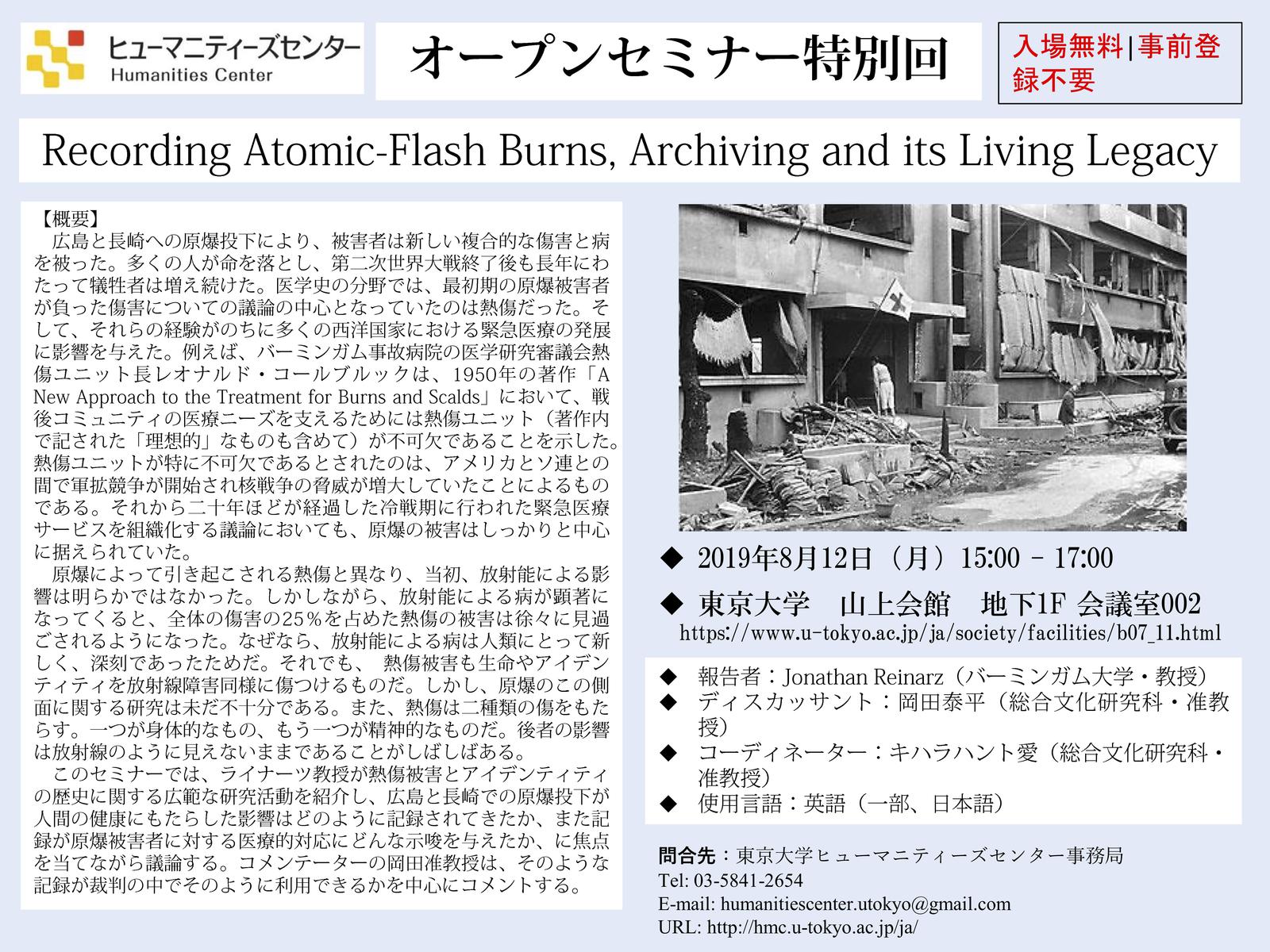ヒューマニティーズセンター オープンセミナー特別回(8月12日)「Recording Atomic-Flash Burns, Archiving and its Living Legacy」

- 日時:2019年8月12日(月)15:00-17:00
- 場所:東京大学 山上会館 地下1F 会議室002(入場無料 事前登録不要)
- 報告者:Jonathan Reinarz(バーミンガム大学・教授)
- ディスカッサント:岡田泰平(総合文化研究科・准教授)
- コーディネーター:キハラハント愛(総合文化研究科・准教授)
- 使用言語:英語(一部、日本語)
広島と長崎への原爆投下により、被害者は新しい複合的な傷害と病を被った。多くの人が命を落とし、第二次世界大戦終了後も長年にわたって犠牲者は増え続けた。医学史の分野では、最初期の原爆被害者が負った傷害についての議論の中心となっていたのは熱傷だった。そして、それらの経験がのちに多くの西洋国家における緊急医療の発展に影響を与えた。例えば、バーミンガム事故病院の医学研究審議会熱傷ユニット長レオナルド・コールブルックは、1950年の著作「A New Approach to the Treatment for Burns and Scalds」において、戦後コミュニティの医療ニーズを支えるためには熱傷ユニット(著作内で記された「理想的」なものも含めて)が不可欠であることを示した。熱傷ユニットが特に不可欠であるとされたのは、アメリカとソ連との間で軍拡競争が開始され核戦争の脅威が増大していたことによるものである。それから二十年ほどが経過した冷戦期に行われた緊急医療サービスを組織化する議論においても、原爆の被害はしっかりと中心に据えられていた。
原爆によって引き起こされる熱傷と異なり、当初、放射能による影響は明らかではなかった。しかしながら、放射能による病が顕著になってくると、全体の傷害の25%を占めた熱傷の被害は徐々に見過ごされるようになった。なぜなら、放射能による病は人類にとって新しく、深刻であったためだ。それでも、 熱傷被害も生命やアイデンティティを放射線障害同様に傷つけるものだ。しかし、原爆のこの側面に関する研究は未だ不十分である。また、熱傷は二種類の傷をもたらす。一つが身体的なもの、もう一つが精神的なものだ。後者の影響は放射線のように見えないままであることがしばしばある。
このセミナーでは、ライナーツ教授が熱傷被害とアイデンティティの歴史に関する広範な研究活動を紹介し、広島と長崎での原爆投下が人間の健康にもたらした影響はどのように記録されてきたか、また記録が原爆被害者に対する医療的対応にどんな示唆を与えたか、に焦点を当てながら議論する。コメンテーターの岡田准教授は、そのような記録が裁判の中でそのように利用できるかを中心にコメントする。
The bombings in Hiroshima and Nagasaki introduced the world to a new combination of injuries and sickness in survivors of atomic warfare. A significant number of people lost their lives as a result of the bombing, but continued to do so for years following the end of the Second World War. In medical history, the injuries sustained by the first victims of the atomic bomb have regularly been the focus of discussions about burns, and their experiences subsequently shaped the development of emergency medicine in many western countries. For example, in his book, A New Approach to the Treatment for Burns and Scalds (1950), Leonard Colebrook, Director of the Medical Research Council's (MRC) Burns Unit at the Birmingham Accident Hospital, suggests that burns units, including the 'ideal' layout described in his text, were essential to serving the medical needs of communities in the years following the war, especially because of the growing threat of further atomic conflicts with the commencement of an arms race between America and the Soviet Union. Two decades later, the impact of the A-bomb was firmly at the centre of discussions concerning the organisation of emergency medical services in the Cold War era.
Unlike the burns caused by the atomic bomb, the influence of radiation was initially invisible. However, when radiation sickness became apparent and started to cause inhumane deaths, burns, which comprised 25% of injuries, were soon overlooked because of the novelty and seriousness of radiation sickness. Nevertheless, burns injuries equally transform lives and identities, and this aspect of the bombing continues to be under-researched. In addition, burns often cause two wounds, one physical and the other mental. This latter impact, like radiation, often remains invisible.
In this seminar, Prof. Reinarz will introduce his wider work on the history of burns injury and identity and specifically discuss how the impact of Hiroshima and Nagasaki bombs on human health were recorded, and what implications that had in terms of the medical response that survivors received. Dr. Okada will make comments on how such record can be used in court proceedings.


